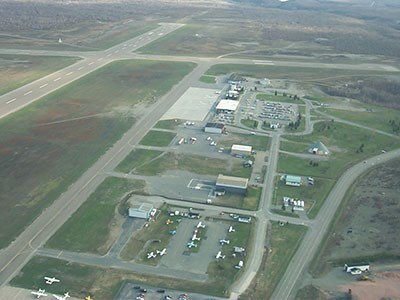After a $3.3-million land development project was completed at the Greater Sudbury Airport last year, the facility is a hive of activity again, this time playing host to a $25-million hangar expansion by the Ministry of Natural Resources (MNR), which will have a lasting impact on the airport.
Expected to take up to two years, the project will involve the renovation of the MNR’s Forest Fire Management Centre, which serves as the hub for coordinating emergency response and forest fire suppression for Northeastern Ontario.
Work includes an addition onto the office building, a large addition to the warehouse facility, and the purchase of a nearby aviation hangar currently owned by the airport, as well as work on the apron, parking lot and the entrance to the facility.
The new construction will follow LEED (Leadership in Energy and Environmental Design) principles. Airport CEO Bob Johnson said the MNR project will have far-reaching impacts on the airport.
“It has a domino effect on the rest of the businesses at the airport, because part of (the MNR’s) expansion plan moves into an area that’s already developed,” he said. “So we have to move some of that development to the new area.”
That new area encompasses nine acres of newly developed land. In 2011, Hollaway Construction of Garson was contracted to install sewer, water and natural gas to 10 large lots, in addition to doing work on a new road, fencing, lighting, taxiways and aprons. The work was completed at the end of 2012.
Now those lots are ready to accept new business, and Johnson said the airport is already entering into leases with some tenants. It’s additionally building a new hangar to replace the one being acquired by the MNR, an estimated $3.5-million project.
“Really, on the land development side, we’re entering probably one of the largest phases in our history,” Johnson said. “We could see $35 to $40 million of development at the airport, which is pretty significant for one small sector of the community. So we’re pretty excited about that.”
The airport has made progress in the general aviation division as well, with Hydro One and the OPP recently setting up small bases out of the Sudbury airport.
Flight school Discovery Aviation Academy, which established an office there in 2011, has been active as well, conducting largescale flight training for the Department of National Defence this summer and working with the Northern Ontario School of Medicine on research projects. The academy is also actively trying to partner with a college on its training program.
“There are multiple opportunities and ways that an airport can be used to attract new business,” Johnson said. Following a surge in scheduled passenger service after Porter Airlines set up at the airport in 2010, Johnson said the airport has seen those numbers flatten out recently. He attributes it partly to the softening economy, but leakage remains a major obstacle.
People are still either driving to their destination or driving to Toronto before catching their flights. Johnson argues that it’s often more economical and convenient for people to fly directly out of Sudbury, but it remains a challenge to get people to recognize the value of air transportation in the community.
Airlines are businesses, he emphasized, and for Porter, Bearskin and Air Canada to remain in Sudbury, passenger numbers have to increase.
The same rings true for any new airline considering an expansion into the Nickel City. Recent rumours have swirled around the idea of wooing WestJet to Sudbury.
“The only way that WestJet could come into our community with the other three carriers, and to find a healthy market share to sustain the business, we need passionate growth,” Johnson said.
Johnson said pricing for air travel is very competitive right now; passengers can often find a one-way flight to Toronto for $110, taxes in, which is reasonable compared to prices of even a few years ago.
The airport is hoping to see the economy, as well as the lagging mining sector, bounce back in 2014, Johnson said, as the development of large mining projects, as well as the establishment of the schools of architecture and mines at Laurentian University could also result in more flights in and out of the airport.




